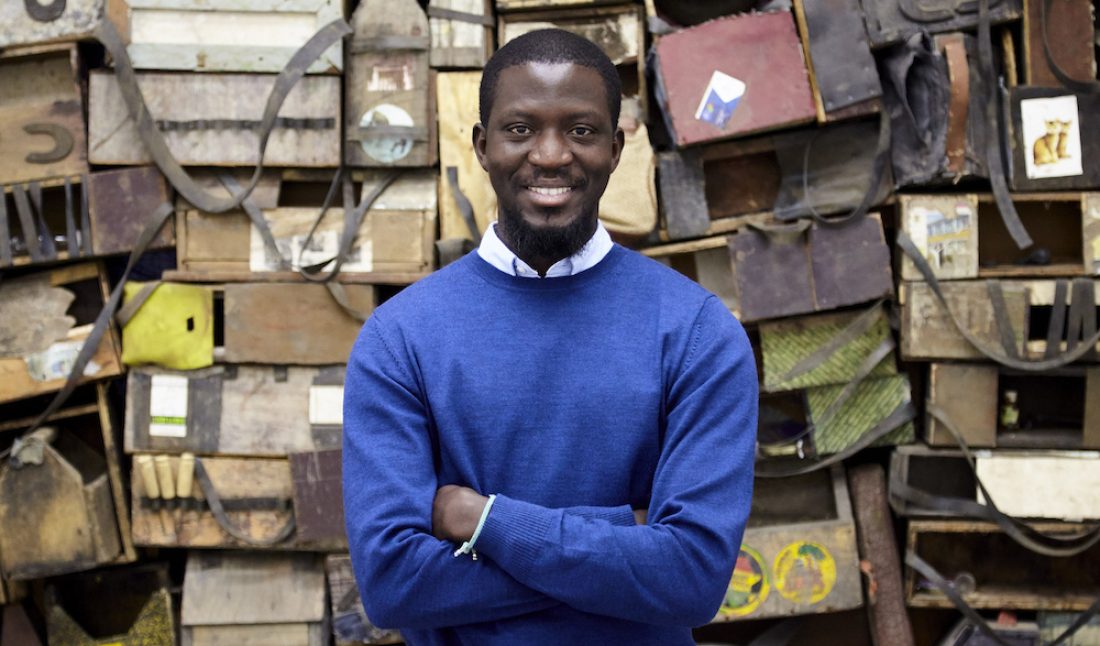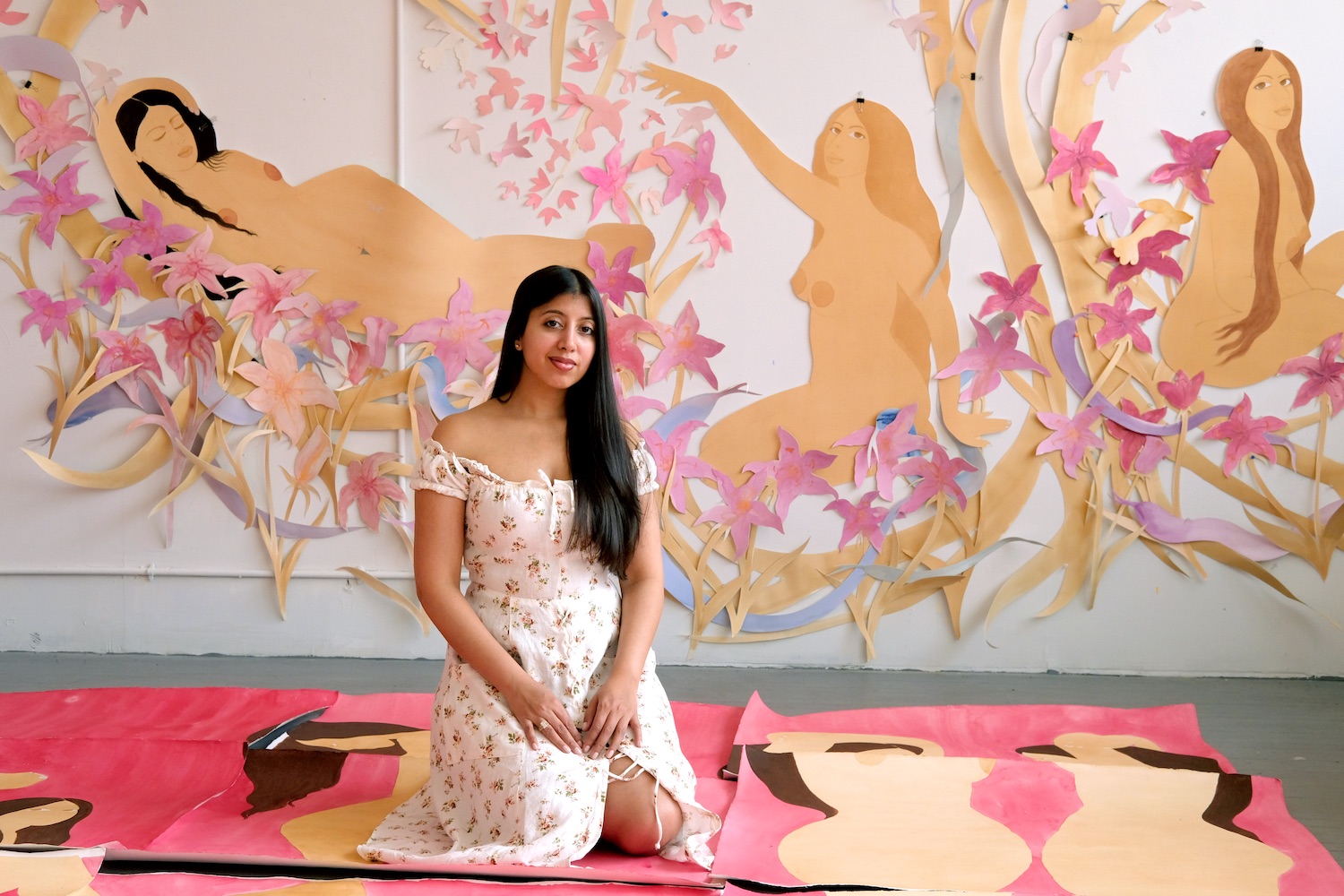Ibrahim Mahama has used and reused jute sacks to cover buildings, public spaces, floors, walls, and passageways. Reused from installation to installation—from Venice to Kassel to Milan and, most recently, Sydney—the stitched-together materials reveal traces of the trade of commodities, as well as the work of the artist and its viewers.
Mahama is a collector of things, from jute sacks to sewing machines, shoeshine boxes, smoked fish grills, photographs, documents, and even trains and planes. Installed en masse, these everyday objects become monumental, and so too does their story of migration, commodities, human labor, globalization.
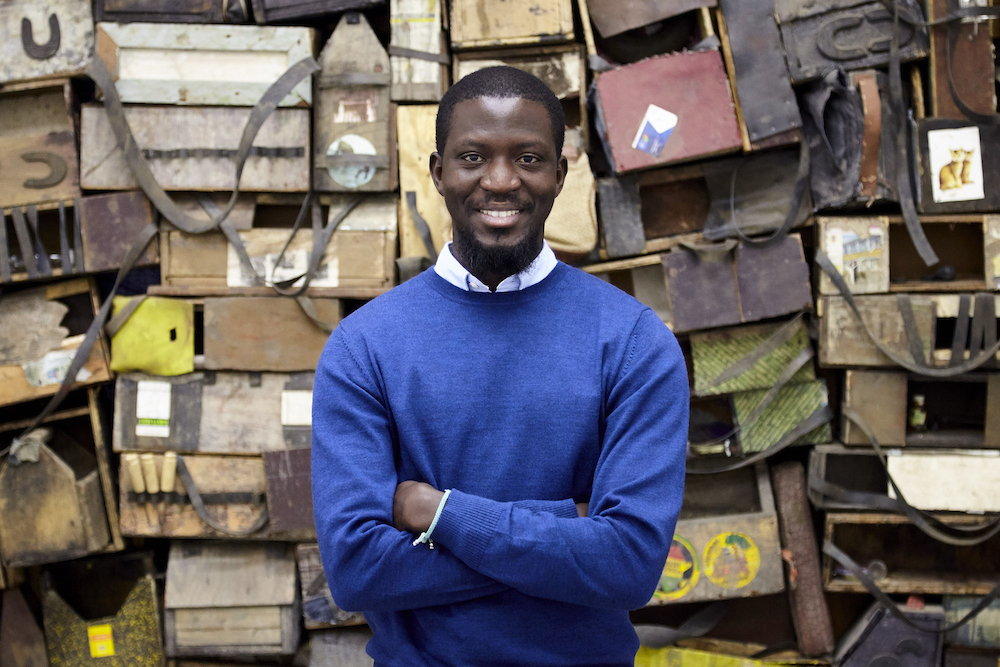 Ibrahim Mahama, photo by George Darrell, courtesy of White Cube.
Ibrahim Mahama, photo by George Darrell, courtesy of White Cube.
The artist was born in Tamale, in the Northern part of Ghana. Last year, he opened there The Savannah Centre for Contemporary Art (SCCA). Mahama wanted to create an institution for the area to offer cultural opportunities. The site is growing to include exhibition spaces, a theater, classrooms, residencies, workshops, studios, and more.
Whitewall spoke with Mahama, who has an exhibition at White Cube in early 2021, about changing perspectives.
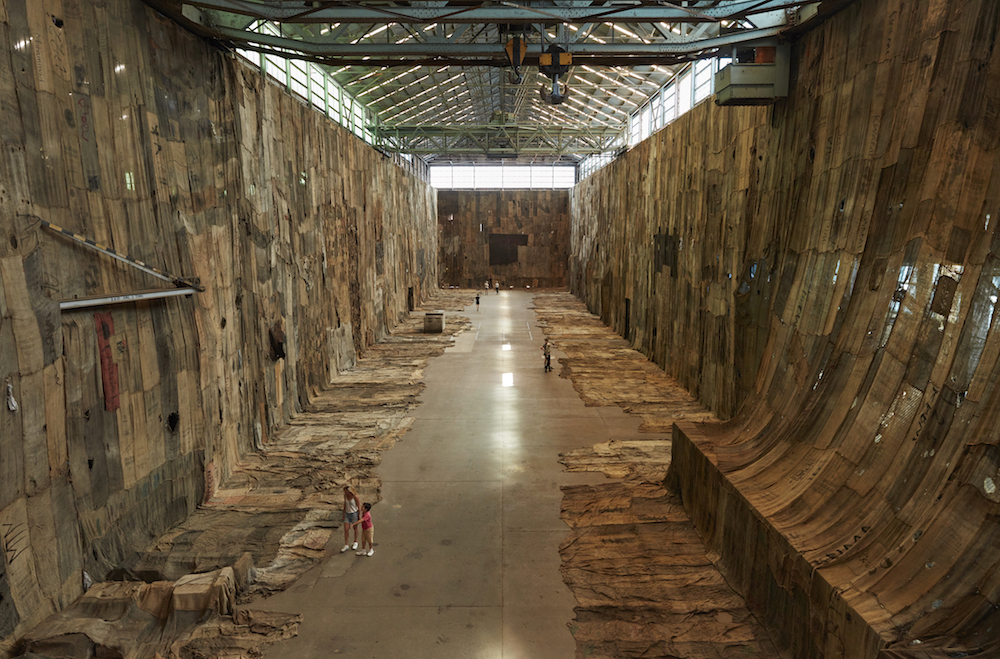 Ibrahim Mahama, “No Friend but the Mountains 2012-2020,” 2020, for the 22nd Biennale of Sydney, Cockatoo Island, courtesy the artist, White Cube, and Apalazzo Gallery, Brescia, photo by Zan Wimberley.
Ibrahim Mahama, “No Friend but the Mountains 2012-2020,” 2020, for the 22nd Biennale of Sydney, Cockatoo Island, courtesy the artist, White Cube, and Apalazzo Gallery, Brescia, photo by Zan Wimberley.
WHITEWALL: Can you tell us about your work in the Sydney Biennale in Cockatoo Island’s Turbine Hall, No Friend but the Mountains, 2012–2020?
IBRAHIM MAHAMA: We decided we were going to cover the interior parts of the Cockatoo Island Turbine Hall. The jute sacks were originally used in Venice in 2015 in “All the World’s Futures,” in documenta, and in Milan last year with the Fondazione Trussardi.
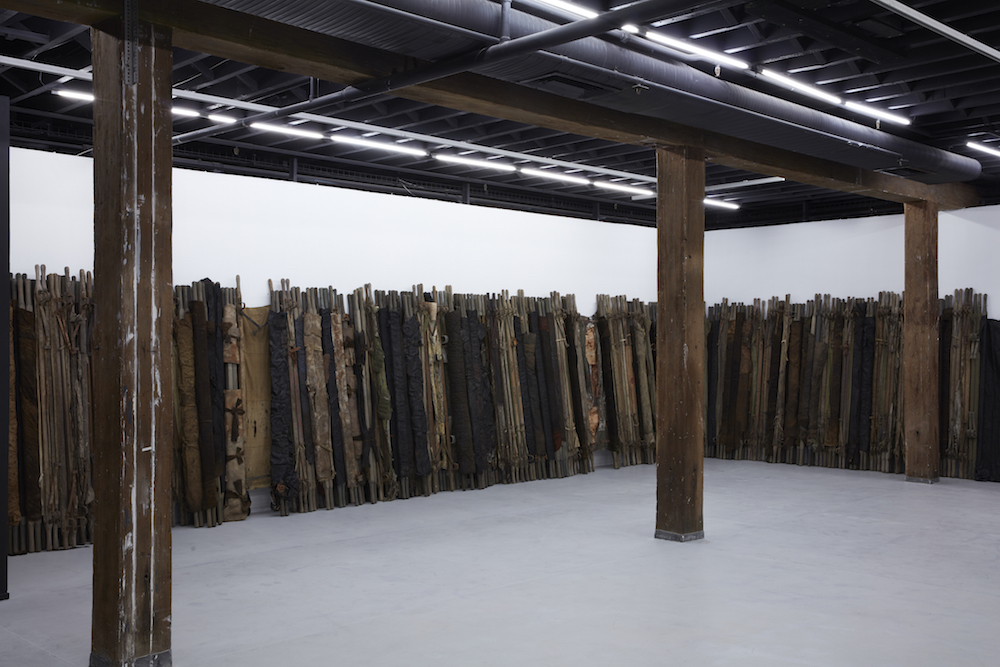 Ibrahim Mahama, “A Grain of Wheat,” 2015-18, mixed media, installation view for the 22nd Biennale of Sydney, Artspace, courtesy of the artist and White Cube, London / Hong Kong, photo by Zan Wimberley.
Ibrahim Mahama, “A Grain of Wheat,” 2015-18, mixed media, installation view for the 22nd Biennale of Sydney, Artspace, courtesy of the artist and White Cube, London / Hong Kong, photo by Zan Wimberley.
The material is used to transport commodities around the world. It is worn, and when the material is sewn together, it goes back to the foundation, the beginning. This time around it’s not containing the commodities; it’s containing architecture and spaces. It’s working with the residues of the commodification the world has produced—the ghosts and traumas of it.
I think part of using these materials and occupying these spaces like Cockatoo Island, is that it allows a moment to reflect on the various histories of the world. These sacks, which come from Ghana, are produced in Bangladesh, used in transports and commodities, end up in Australia, or America, without compensation of appropriate labor forms. The aesthetics they invoke have always been very political, in terms of the meanings that they inscribe. I’m more or less interested in what those aesthetics mean and how they can help us to rethink art from a social-political point of view.
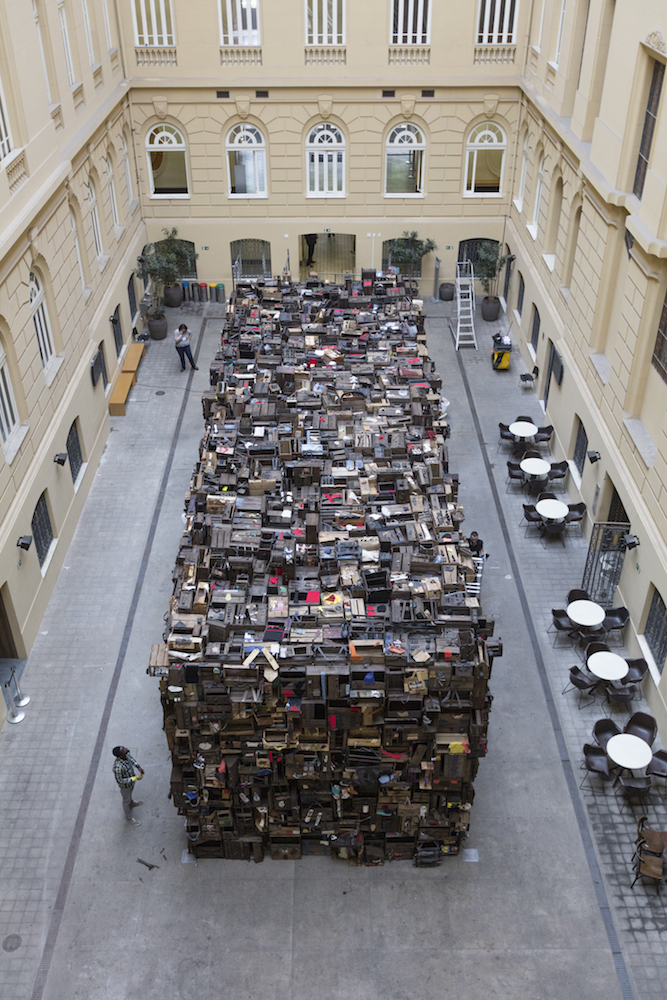 Ibrahim Mahama, “Non Orientable Paradise Lost 1667,” 2017, Centro Cultural Banco do Brasil, Belo Horizonte, Brazil, photo by Ibrahim Mahama.
Ibrahim Mahama, “Non Orientable Paradise Lost 1667,” 2017, Centro Cultural Banco do Brasil, Belo Horizonte, Brazil, photo by Ibrahim Mahama.
WW: You’ve said that you’re interested in the ability as an artist to change our perspective. How does that impact your choice of the scale of a work?
IM: I like the idea of the everyday. But I also want to complicate the idea of the everyday because when you see something every day on a human scale, you become numb to it. But when you see it on a very large scale, suddenly it draws you in.
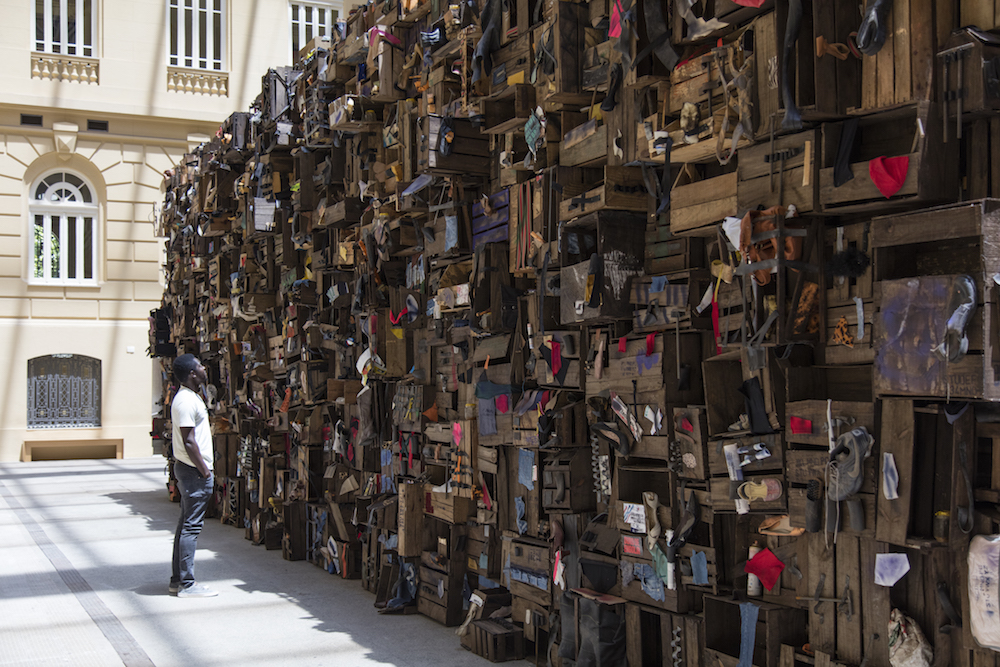 Ibrahim Mahama, “Non Orientable Paradise Lost 1667,” 2017, Centro Cultural Banco do Brasil, Belo Horizonte, Brazil, photo by Ibrahim Mahama.
Ibrahim Mahama, “Non Orientable Paradise Lost 1667,” 2017, Centro Cultural Banco do Brasil, Belo Horizonte, Brazil, photo by Ibrahim Mahama.
In Ghana, jute sacks are used to transport cocoa jute once, and afterward it’s sold through middlemen to traders in the market who use it to bag rice, charcoal, and many other things. It comes to its lowest point when it is used to transport charcoal. And the people who are associated with the production of charcoal, where they come from within the country, it almost seems like they’re at the very bottom of the chain. But charcoal is also one of the most important fuel sources that we use in the country. So I became interested in the paradoxes within the material itself and what it comes across.
When the material is emptied eventually, I as an artist take the material devoid of the commodity inside. And you take an interest in it as something which has somehow contained time itself, or the history of the world itself as a vessel. It’s not just material; it’s also very ideological with the trace of labor forms attached to it.
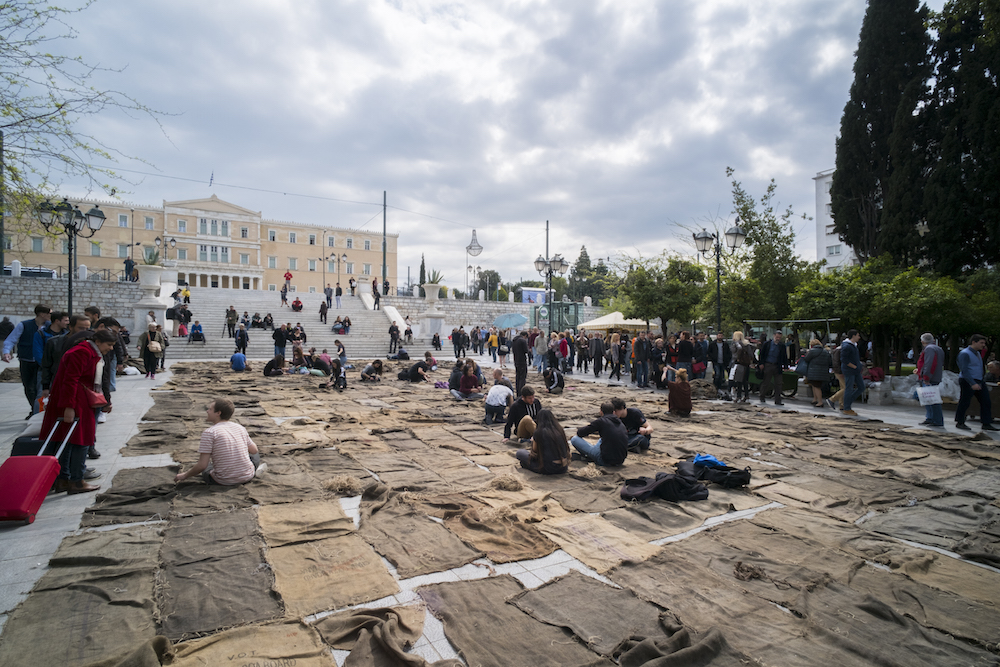 Ibrahim Mahama, courtesy of Mathias Voelzke.
Ibrahim Mahama, courtesy of Mathias Voelzke.
When you now scale up the material by sticking them together to a large scale, it’s very subtle and beautiful. But when you look closely, it’s also very disturbing in terms of the history that it unpacks. You realize there is something traumatizing about the aesthetics that it produces.
WW: You’ve been working on an installation at the High Line in New York as well. Can you tell me about that project, 57 Forms of Liberty?
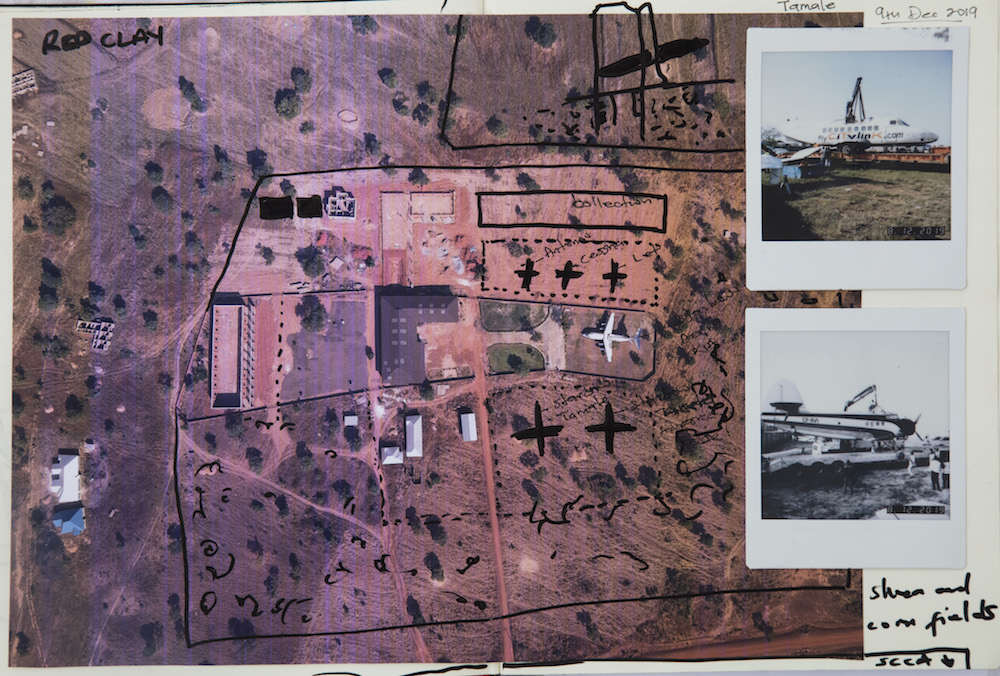 Red Clay Notes, courtesy of Ibrahim Mahama.
Red Clay Notes, courtesy of Ibrahim Mahama.
IM: That is a piece that was conceived also from a building in the Western part of Ghana, in Sekondi-Takoradi. There is a foundry that was being used to restore materials to fix parts of the trains that were damaged. Over the years they stopped, since the post-Independence era, after the railway started declining in Ghana. A lot of the facilities within the workshop are no longer in operation. So I took an interest. I used to go there a lot because it was one of the spaces I worked in. I also collected materials for projects like Parliament of Ghosts, and many past works.
I took an interest in the chimney because it started growing plants in it. There was a tree that depending on the season the leaves would fall off or it would come back to life.
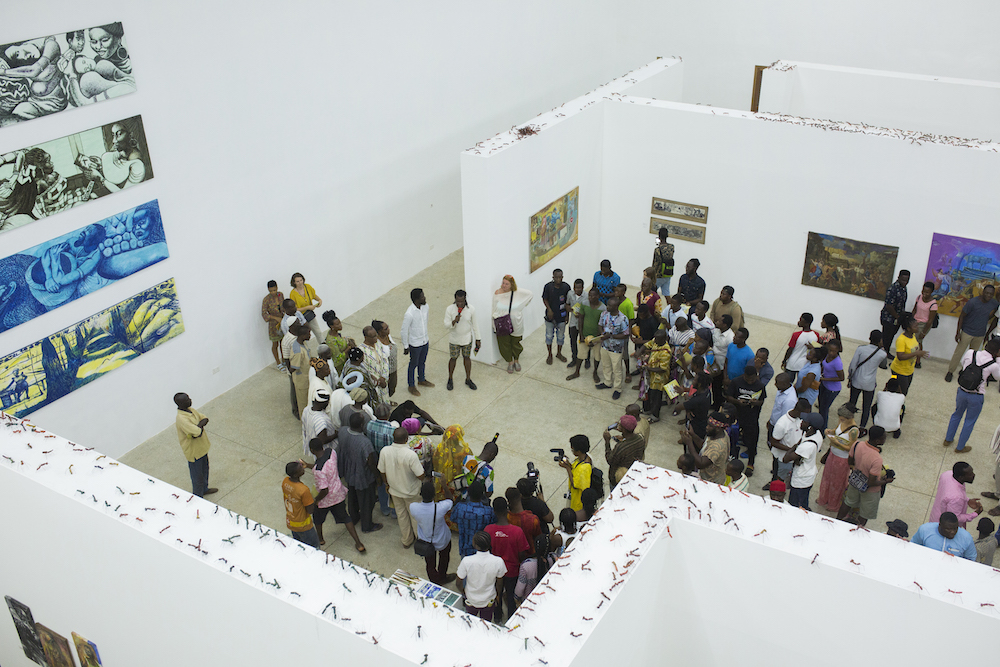 View of “Galle Winston Kofi, Dawson – In Pursuit of Something Beautiful Perhaps…” (2019), photo © Savannah Centre for Contemporary Art, Tamale.
View of “Galle Winston Kofi, Dawson – In Pursuit of Something Beautiful Perhaps…” (2019), photo © Savannah Centre for Contemporary Art, Tamale.
I took an interest in it, in looking at the paradox that was on display within that—a place where the heat of fire is supposed to come from is suddenly a place where life is growing. And this life form is not intentional.
I thought it was interesting to take it as an idea to produce a work for the High Line, because of its history, and also because when you look at it from afar, with a long-range telescope or camera lens, it looks like the torch of the Statue of Liberty. And it’s on part of the High Line where you can see the Statue of Liberty.
WW: You’ve established the SCCA in Tamale, in the North of Ghana, which has now been open for a year. Part of the mission there is to change young people’s sense and understanding of culture. Why is that important to you?
IM: I think we have to focus on the younger generation because one of the big problems that we have within our society today is mostly due to ideological conflicts.
Tamale is where I was born. It’s the third-largest city in Ghana, but in terms of population, it’s very little compared to the first and second-largest cities, Accra and Kumasi. Landmass is very big, and at the same time, it’s quite affordable to live in. It also has a lot of historical sites.
I thought it could be interesting to experiment with building this institution that could propose different ways we could interact with the city and also live their daily lives. There are no cultural institutions in Tamale. There are not even parks. It means that young people don’t have cinemas, don’t have art galleries. We need spaces that allow moments of reflection and moments of coming together to ask certain questions.
The idea for SCCA was to create a platform that would have exhibitions, a library that people could access, to host film screenings, to host public talks and conversations, to host an art school. We do workshops.
And I started looking at ways in which we could expand it, so I’m building a different space, called Red Clay. It has airplanes and other things like a playground and parks and a studio for artists.
WW: For Red Clay, why did you want to use things like airplanes and other interesting spaces?
IM: The airplanes are quite fascinating because they defy the very laws of humanity. A lot of kids really get excited when they see it. Several years ago, I was really interested in expanding the objects I was working with. As a child growing up, driving by the airports, I would always see these airplanes parked. And parked for years. So when I became the artist that I am today, I started asking questions, like, “Is it possible to acquire some of these objects and then transform them?”
I started negotiating for the airplanes, and we managed to transport them to Tamale. The idea is to remove all the seats, and I’m building these cinemas with those seats, and seats from old state-owned buses. I like to reappropriate objects that have been used and are at the end of their life cycles.
Red Clay will contain an archival room, a photographic lab, and then we have a studio that can also be used as an exhibition space. It has artists’ residencies to host long- and short-term. It has another vast exhibition hall, which can be used in large-scale installations and can also be converted in studios when it needs to be. We also have a park and a garden and then some farms, so it’s quite big, the land is very big, so there are a lot of things. We also have sound recording and film editing studios as part of the institution.
The idea is to be able to create a nonprofit institution that allows for the production of knowledge and the preservation of history, bringing people together in a community.
WW: How has working on SCCA informed your personal practice?
IM: I see it as a practice in itself. I had to fund it all independently from the sale of my work. Sometimes the contradiction is the capital and the market also produces certain things. When artists tend to live from their work, it almost becomes some kind of a reward. I don’t want it to be a reward. I want the residues that are produced from the work to translate into something else, to somehow come back and affect the very conditions in which the work was produced.
The jute sacks are coming from a system of inequalities. Suddenly, the aesthetics are broken down to a point where it’s no longer valuable, but, through our art, something magical happens to it, and it transforms it into a kind of commodity that is sold to museums and collectors. So then what happens to the money? I think the money can also be seen as some kind of material which can come back and create new institutions.
Imagine all these years, institutions collect all the very important artworks from around the world, particularly from the continent. We don’t have institutions that are built. So there are no ways for young people to experience the significant work that artists make. I don’t want that to be the case in my generation with my own work. I want to create spaces that contextualize and change the very reality of how people experience art and read meaning into it.






